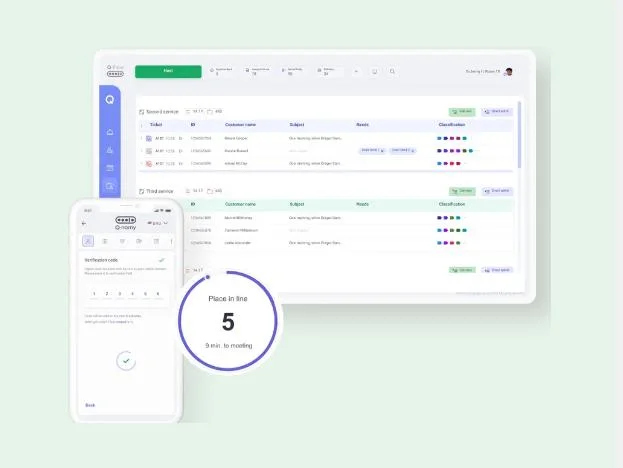Let’s discuss a common pain many large companies face: long queues, overworked staff, and growing frustration. These annoy customers and decrease business, as dissatisfied customers leave and never come back.
Queue management systems can solve this problem by bringing order to your chaos. Customers are satisfied, staff work efficiently, and everything runs smoothly.
It’s about maximizing ROI: implementing these systems enhances your business and creates a real impact.
Curious how these solutions could benefit your organization? Let’s take a closer look at how they can drive operational excellence!
The Unique Operational Challenges of Large Enterprises
Large enterprises often grapple with their unique challenges due to their scale and complexity.
Managing vast numbers of customers and employees across multiple locations presents unique obstacles, including:
- High Volume of Customers: Large businesses serve thousands daily, resulting in long wait times and crowded areas needing more efficient management.
- Resource Allocation: Managing staff assignments and optimizing resources across multiple service points can be challenging without the right tools.
- Operational Complexity: Many organizations need to connect departments and locations effectively.
If left unattended, these operational problems can cause inefficiencies, difficulty in business operations, low employee morale, and a lousy customer experience.
How Queue Management Systems Address Operational Challenges
Queue management systems automate customer handling, boosting efficiency and enhancing the customer experience for enterprises.
Customer Flow Management: Queue systems help support the orderly service of customers, reducing bottlenecks and wait time.
Dynamic Resource Allocation: These systems help managers allocate staff more effectively based on real-time data about customer traffic, ensuring that every area is manageable.
Centralized Control: Enterprises with multiple locations can manage queues across different branches, ensuring a unified and consistent customer experience.
Enhancing Workforce Efficiency
Queue management systems boost workforce efficiency by optimizing staff allocation in large enterprises.
Queue systems can assist by:
- Optimizing Workloads: Accurate data helps managers allocate staff to high-traffic areas, avoiding under- or overstaffing.
- Reducing Idle Time: Staff rotation is optimized as the system adjusts to customer flow, boosting productivity.
- Task Prioritization: The system manages customer queues, allowing employees to focus on delivering quality service.
Data-Driven Decision-Making for Operational Excellence
Big enterprises actively monitor peak hours and service rates to ensure data-driven decisions.
Managers can then use this data to:
- Identify Trends
By analyzing customer patterns and trends, managers can forecast busy periods, allocate resources efficiently, and adjust staffing levels, improving service delivery and ensuring a smoother customer experience during peak times.
- Performance Monitoring
Features such as real-time data allow organizations to measure employee and department performance more effectively, pinpointing inefficiencies faster. This ultimately leads to better productivity and drives continuous operational growth.
- Continuous Improvement
Enterprises can adopt a strategic approach to necessary changes and market demands and keep iterating their operations to meet business needs by using data—a strong motive for enduring success.
Improving Customer Experience and Satisfaction

Operational excellence results from customer satisfaction, and customer queue systems are essential.
Large enterprises rely on these systems to ensure a positive customer journey by:
- Reducing Wait Times: These systems significantly shorten wait times, a key factor in customer dissatisfaction.
- Providing Transparency: Customers can check their line position through displays or mobile devices, easing anxiety.
- Enhancing Communication: Clear instructions on where to go and when to be served create a more organized atmosphere.
With shorter wait times, smoother processes, and better communication, customer satisfaction improves dramatically, giving large enterprises a competitive edge.
Benefits for Large Enterprises Across Industries

Large enterprises can reap significant benefits from implementing these systems regardless of the industry.
Whether in retail, healthcare, government, or banking, these systems provide:
Scalability
As enterprises grow, their systems need to keep pace. Queue management software is scalable, accommodating growing customer bases and expanding operations.
Customizability
Each industry has unique needs. For instance, healthcare facilities might prioritize emergency patients, while retail stores may focus on handling customer returns. You can tailor queue systems to meet specific requirements.
Cost Savings
By optimizing staff use and reducing customer churn, enterprises can save on operational costs while improving service quality.
What’s the Bottom Line?
Intelligent, scalable solutions make large enterprises reliable and efficient. Queue management systems are a big part of ensuring that everything runs smoothly in enterprise operations.
Such systems increase workforce productivity, make it easier to create insights from data, and, most notably, improve customer satisfaction.
Queue management systems should be integrated to ensure smooth and efficient operation as businesses scale beyond this limitation. Companies like Q-nomy confidently deliver customized services to enhance the enterprise operations of large corporations significantly.
Please leave a comment and share your views or experiences in the same journey; also, drop any questions you may have during this!!









